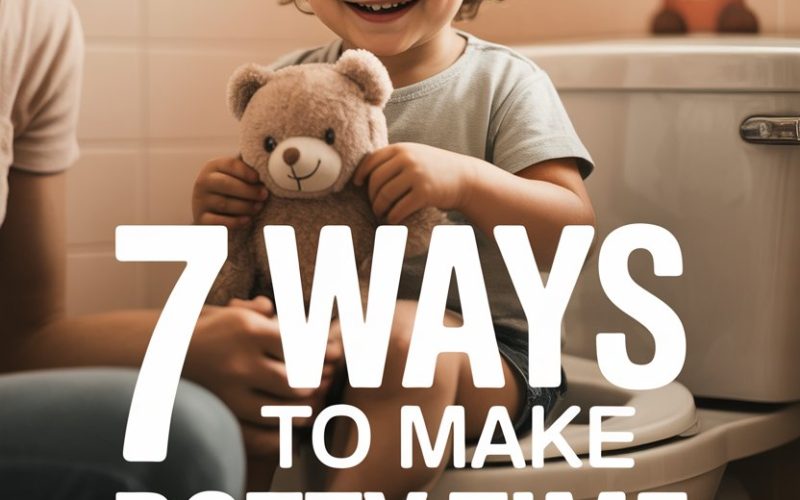Potty training. Two words that strike fear into the hearts of even the most intrepid parents.
Somehow, you survive sleepless nights and the Great Pureed Carrot Incident of 2022, only to be confronted by a tiny tyrant terrified of a plastic commode. You’re busy, you’re tired, and you’d very much like your bathroom back.
The good news? There are ways to make this milestone more giggle than tears—for you and your not-so-eager trainee.
Here’s how to take some of the terror out of toilet time and maybe, just maybe, reclaim a shred of dignity along the way.
1. The Magic of Familiarity
Imagine someone plopping you down on a mysterious throne, then expecting you to relax and do your business while they cheer you on. Odd, right?
For toddlers, the potty is a strange object, and the bathroom might as well be a haunted house.
Ease the fear by introducing the potty as early as you like, with zero pressure. Let it hang out in the living room or wherever your child plays. (Yes, your mother-in-law will have thoughts. She can add them to her list.)
Toddlers are naturally curious, so give them plenty of time to inspect, touch, and even decorate their new seat.
Some families swear by allowing little ones to practice sitting on the potty fully clothed to start, which research backs up as a gentle way to lower resistance.
When the potty becomes another everyday object—like a favorite chair or, let’s be honest, the ever-present tablet—it loses much of its spooky power.
2. Lighten the Mood With Laughter
Potty training involves messes, misplaced aim, and the occasional mystery puddle. If you can’t laugh, you’ll cry—possibly both.
Bring humor into the process. Read silly potty books together: “Everyone Poops” isn’t just a classic, it’s a bonding opportunity.
There’s Potty by Leslie Patricelli, or for fans of rhyme, “P is for Potty!” from Sesame Street.
The goal is to normalize bodily functions, showing your child that everyone—from Mummy to the family cat—has to go at some point.
Songs work wonders, too. Make up a ridiculous tune or find a playlist designed for this very purpose. (Yes, there are actual potty playlists. No, you’re not the only parent humming “Potty Time” at the supermarket.)
Laughter takes the edge off anxiety. It also makes for great stories to trot out at embarrassing family gatherings a decade down the line.
3. Channel the Power of Positive Peer Pressure
Little ones are notorious copycats. If their mate at nursery is suddenly sporting “big kid” undies, you can be sure your child is paying attention.
If you’re in a position to do so, arrange playdates with children who are already using the loo. Even just being in the same bathroom as an older sibling during their routine (with everyone’s consent, of course) can work wonders.
No lectures needed—just a chance for your child to see that the big scary potty doesn’t actually bite.
Some nurseries and playgroups naturally provide these opportunities.
For the at-home crowd, try showing a cartoon character’s potty training episode—“Daniel Tiger’s Potty” is a crowd favorite, and child development experts recommend videos for modeling.
If you’re feeling brave, let your child pick out their own “training pants” or undies. Nothing motivates like a pair of dinosaur briefs.
4. Keep Your Cool When Accidents Happen
Every parent has a story involving a puddle, a pile, or an inexplicably damp teddy. Accidents happen. They are part and parcel of the process.
How you react when it all goes pear-shaped makes a world of difference.
Kids are exquisitely attuned to your vibe. If you keep it breezy (“Oops, looks like we didn’t make it this time. No worries!”), your child is much less likely to develop anxiety around the potty.
Research from the American Academy of Pediatrics suggests that punishment or shaming can backfire, leading to withholding or even regressions
. Instead, arm yourself with extra wipes, plenty of spare clothes, and the patience of a saint. (Or at least, the patience of someone who knows they’ll laugh about this one day.)
Stick a few waterproof mats around the house and give yourself permission to care less about the carpets for the next few weeks.
5. Turn Potty Time Into a Mini Celebration
Toddlers live for positive attention. A tiny high five, an enthusiastic cheer, or a sticker can make all the difference.
Create a mini reward system tailored to your child. Some families use sticker charts, others prefer a special dance or a phone call to Grandma.
Keep the rewards small and instant—think a stamp on the hand or a favourite song, rather than a trip to Disneyland for every successful tinkle. (Although, if you find travel deals that good, do share with the class.)
The key here is to celebrate effort, not just success. Sitting on the potty—even without results—deserves a little recognition. This approach builds confidence, reduces fear, and lets your child know you’re on their team.
For inspiration, check out expert recommendations on positive reinforcement, which reinforce this approach as crucial for toddler learning.
6. Tame the Flush Monster
Here’s a fun fact: Many tiny humans are absolutely petrified of the flush. The noise, the swirling water, the sense that something is being sucked away forever—it’s a lot to process when you’re two.
Try turning the flush into a ritual rather than a surprise attack. Invite your child to press the button or pull the handle themselves when they’re ready.
If the sound is scary, muffle it by closing the lid first, or let them flush from a “safe” distance.
Set expectations: “The toilet makes a loud whoosh to help us keep things clean.” Some families even name the flush (“Bye bye, Poo-Poo!”) and wave.
Is it ridiculous? Absolutely. Does it work? You’d be surprised.
When possible, avoid automatic flush toilets for a while—those sneaky sensors have startled more than one potty trainee into a full regression.
7. Routine, Routine, Routine
Consistency is the secret sauce of potty success. Children thrive on predictability; it helps them feel safe and in control.
Create a routine that cues your child when it’s time for a pit stop. Common triggers include waking up, before and after meals, before leaving the house, and before bed.
You’re not aiming for military precision—just gentle reminders that keep the idea front and centre.
Visual schedules can help if your child is especially routine-loving.
Many parents swear by setting a gentle timer (there are actual potty training timer apps if you’re keen), but don’t be ruled by the clock. Some kids need a nudge, others prefer to call the shots.
The more often your child sits on the potty, the less mysterious (and scary) it becomes. Before you know it, it’s as routine as washing hands—well, almost.
Potty Triumphs Are Closer Than You Think
Potty training may never be your favourite phase, but it doesn’t need to be a horror show. With patience, a bit of playfulness, and the occasional deep breath in the hallway, your child will get there.
And you? You’ll have a treasure trove of stories, a newfound respect for stain removers, and—one day soon—a toilet all to yourself. Call that a win for the ages.





